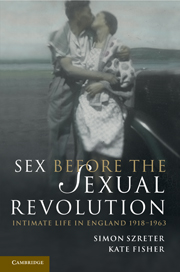Book contents
- Frontmatter
- Contents
- Acknowledgements
- 1 Introduction
- Part I What was sex?
- Part II What was love?
- Part III Exploring sex and love in marriage
- 10 Conclusion: private lives
- Appendix A The oral history sample: summary of project design and socio-demographic characteristics of the interviewees in Blackburn and north-west Hertfordshire
- Appendix B Note on social classification of the respondents
- Appendix C
- Bibliography
- Index
- Index of interviewees
Appendix A - The oral history sample: summary of project design and socio-demographic characteristics of the interviewees in Blackburn and north-west Hertfordshire
Published online by Cambridge University Press: 05 June 2012
- Frontmatter
- Contents
- Acknowledgements
- 1 Introduction
- Part I What was sex?
- Part II What was love?
- Part III Exploring sex and love in marriage
- 10 Conclusion: private lives
- Appendix A The oral history sample: summary of project design and socio-demographic characteristics of the interviewees in Blackburn and north-west Hertfordshire
- Appendix B Note on social classification of the respondents
- Appendix C
- Bibliography
- Index
- Index of interviewees
Summary
According to the most recent historical demographic research on England and Wales by Szreter (1996) and by Garrett et al. (2001), reproductive patterns during the fertility decline were extremely locally diverse, not only in terms of social class, but also community and ‘place’. Before this project was initiated Kate Fisher had commenced her doctoral oral history study of working-class birth control in the South Wales collieries and in the city of Oxford. Therefore, two complementary contrasting communities were selected for this investigation and also a middle-class sample was included from each of the two new locations. The textiles towns of both Lancashire and the West Riding of Yorkshire are considered to provide the greatest working-class contrast to the country's coal-mining communities, in terms of their reproductive patterns during the fertility decline. Whereas mining families recorded the highest fertility in the 1911 national census, workers in the textiles industries exhibited among the lowest fertility in the working class, as low as some sections of the middle and lower middle classes. Blackburn in Lancashire was selected as a representative mill town. It had a high proportion of women weavers in the workforce and had characteristic low fertility in 1911. For a further dimension of contrast, a thoroughly middle-class community was sought. A district centred on Harpenden, along with a cluster of nearby affluent commuter towns in north-west Hertfordshire, just outside London, was selected as it exhibited some of the highest concentrations in England and Wales of residents in the Registrar-General's Social Classes I and II at the 1951 census.
- Type
- Chapter
- Information
- Sex Before the Sexual RevolutionIntimate Life in England 1918–1963, pp. 388 - 391Publisher: Cambridge University PressPrint publication year: 2010



